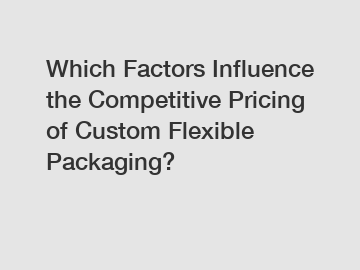Feb. 09, 2024
Packaging & Printing
Which Factors Influence the Competitive Pricing of Custom Flexible Packaging?
In the highly competitive world of packaging, businesses are constantly looking for ways to stand out from the crowd. One effective strategy that many companies employ is custom flexible packaging, which allows them to create unique and eye-catching designs tailored specifically to their products. However, when it comes to pricing this type of packaging, there are several key factors that come into play. In this blog post, we will explore the various elements that influence the competitive pricing of custom flexible packaging.
1. Material Costs.

One of the primary considerations when pricing custom flexible packaging is the cost of materials. The composition and quality of the materials used directly impact the overall price. High-quality materials might be more expensive, but they often result in superior packaging that effectively protects the product. Factors such as durability, flexibility, and resistance to moisture or impact need to be taken into account while selecting the right materials.
2. Design Complexity.
The complexity of the design is another crucial factor that affects pricing. Detailed and intricate designs may require more time, effort, and skill, which in turn increases the costs involved. Customers looking for unique and eye-catching designs should be prepared for a higher price tag. However, it is important to remember that an aesthetically pleasing design can significantly enhance product visibility and brand appeal, making it a worthy investment.
3. Printing Techniques and Finishes.
The printing techniques and finishes used on custom flexible packaging also play a role in determining the final price. Advanced printing technologies, such as digital or offset printing, enable high-quality graphics, vibrant colors, and fine details, but they might be more expensive. Finishes like laminations, embossing, or spot UV coatings add an extra touch of elegance to the packaging, but come at an additional cost. These techniques and finishes contribute to the overall appeal of the packaging, making it more alluring to potential customers.
4. Quantity and Order Size.
The quantity and order size have a significant impact on the pricing of custom flexible packaging. Bulk orders often result in lower unit costs as manufacturers can leverage economies of scale. Businesses that require packaging in large quantities should consider negotiating volume discounts with their packaging suppliers. Additionally, larger orders help manufacturers optimize their production process, ultimately reducing costs per unit.
5. Customization Requirements.
The level of customization required for the packaging is another influential factor. Some businesses may require straightforward customization, such as adding their logo or brand colors, while others may need a completely unique design. Greater customization generally implies additional design and setup costs. However, personalized packaging can strengthen brand image and differentiate products from competitors. Companies aiming to leave a lasting impression on consumers should consider investing in customization.
6. Sustainable Packaging Solutions.
In recent years, there has been an increasing demand for sustainable packaging solutions. Businesses that prioritize environmentally friendly packaging may opt for materials that are recyclable, biodegradable, or compostable. While sustainable options can have a higher initial cost, they are often perceived as more valuable by consumers. Incorporating sustainable packaging materials and practices not only aligns with corporate social responsibility but also enhances the brand's reputation.
7. Production Speed and Lead Time.
Production speed and lead time are critical factors in competitive pricing. Businesses with urgent or time-sensitive packaging requirements may need to pay higher prices to ensure faster production and delivery. Manufacturers that can efficiently meet tight deadlines often charge a premium for their expedited services. It is crucial to balance the need for quick turnaround times with the overall cost to ensure both customer satisfaction and economic feasibility.
Conclusion.
Pricing custom flexible packaging involves considering multiple factors that influence the final cost. Material costs, design complexity, printing techniques and finishes, order size, customization, sustainability, and production speed all play a role in determining the competitiveness of pricing. Businesses seeking custom flexible packaging must carefully evaluate these factors to strike a balance between cost-effectiveness and the visual appeal of their products. Furthermore, working with a reliable and experienced packaging supplier who understands these dynamics can help navigate the complexities of competitive pricing in this dynamic market.
For more information, please visit flat stock pouch, types of pouch packaging, custom baby food pouches.
Previous: Which Design Innovations Make Child Resistant Pre Roll Tin Boxes Safer and More Convenient?
If you are interested in sending in a Guest Blogger Submission,welcome to write for us!
All Comments ( 0 )